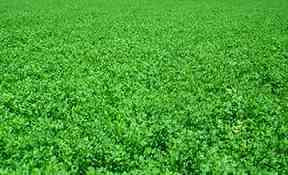|
|
 |
| Welcome | Getting Started | Resources | Site Map |
Week 4
Roughages |
Instructions for listening to audio clips
- Download the QuickTime Player to listen to the audio files.
- Read the QuickTime Instructions for installation help.
- Download the RealPlayer to listen to the audio files
- Instructions are on the RealPlayer download page
Classes of Forage: Legumes
Follow along with the audio...
- Leguminosae family
- Examples: alfalfa and clovers
- Nitrogen fixation
- Process
- Rhizobia microorganisms in nodules associated with root system convert atmospheric nitrogen as N2 to NH3
- Ammonia fulfills nitrogen requirement of legume
- Do not require application of nitrogen
- Symbiotic relationship
- Figure 8.6 – Root nodules
- Nutritional value of legumes
- Compared to grasses, higher in CP, DE, Ca, and Mg
- Planting of legumes and grasses in one system
- Improve nutritional value
- Increase productivity
- Species adapted to range of environmental conditions
- To learn more about legume species
- Alfalfa
- Introduction
- In world and in U.S., most popular forage legume
- Figure 8.7 – Alfalfa field
- Figure 8.8 – Alfalfa plant
- In U.S., 1999, greater than 84.3 million tons of alfalfa hay produced
- Growing conditions
- Varieties developed to grow in variety of climatic and soil conditions, given adequate water
- Prefers well-drained, fertile, slightly alkaline, deep, loam soils
- Productive
- Feeding livestock
- Hay, silage, pasture, and dehydrated meal
- All domestic species
- Especially important for ruminants with high nutrient requirements
- Feeding value
- Nutritional value
- Source of fibrous carbohydrates, protein, energy, minerals (i.e. Ca, P, Mg), and vitamins
- Palatable
- Time of harvest
- Influence quality, yield, and longevity
- Figure 8.9 – General relationship between quality and yield for forage grasses and legumes
- As alfalfa matures
- Quality decreases
- Change in plant components
- Greater proportion of plant is stems and lesser proportion is leaves
- Compared to stems, leaves are higher in protein, lower in fiber, and higher in digestibility
- Yield increases
- Earlier harvested relatively higher CP, lower structural CHO, higher digestibility and lower yield
- Table 7-3 on page 121 in text – Effect of stage of maturity on digestibility of alfalfa
- Crop or stand longevity
- Depletion of CHO reserves in root will decrease longevity
- Earlier harvest
- Overgrazing
- Varieties developed to reduce detrimental effect from early harvest
- Cutting frequency
- Table 7-4 on page 122 of text – Effect of different alfalfa cutting frequencies on yield, quality, weeds, and longevity
- Additional forage legumes
- For additional information
- Clovers
- Red clover
- Compared to alfalfa
- Similar nutritional value
- Less productive
- Fresh or preserved forage
- White clover
- Pasture forage
- Resistant to grazing
- Complements nutritional composition of grasses
- Alsike
- Sweetclover
- Subterranean or sub clover
- Annual
- Crimson
- Annual
- Additional temperate forage legumes
- Trefoils
- Birdsfoot trefoil
- Compared to alfalfa
- More tolerant of infertile, poor-draining, acidic soils
- Lower productivity and quality
- Moderate to high in tannins
- At moderate levels
- Increase proportion of rumen by-pass protein
- Reduce incidence of bloat
- Lespedezas
- Southeastern region
- Nutritional value of annuals greater than perennials
- Vetch
- Multiple species
- Bloat
- Primary potential issue
- Nutritional disorder
- Excess accumulation of gases in tract
- Distention of reticulorumen
- Etiology
- High content of readily available carbohydrates in legumes
- Fermentation produces gases
- High content of soluble proteins in legumes
- Associated with production of stable foam
- Stable foam prohibits eructation of gases
- Accumulation
- If not treated, may lead to death
- High content of readily available carbohydrates in legumes
- Treatment
- Release of gases and use of antifoaming agent
- Prevention
- Feed legumes as hay versus fresh
- Use of low-bloat varieties
- Prevention of initial overconsumption
- Use of antifoaming agent
- Incidence varies by legume
- Additional antinutritional components
- Coumarin
- Clovers; especially sweetclover
- Tannins
- Lespedezas and trefoils
- Alkaloids
- Lupines
- Saponins
- Alfalfa
- Phytoestrogens
- Number of legumes; especially sub clover
- Varieties and prevention techniques to reduce impacts




|
|
| Welcome | Getting Started | Resources | SiteMap |